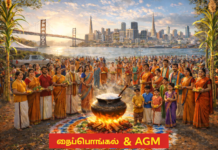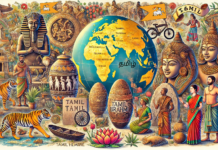Tamil is a Dravidian language spoken predominantly by Tamil people of the Indian subcontinent. It has official status in India, Sri Lanka and Singapore. Tamil is also spoken by significant minorities in Malaysia, Mauritius, Vietnam, Runion as well as emigrant communities around the world. It is the administrative language of the Indian state of Tamil Nadu, and the first Indian language to be declared as a classical language by the government of India in 2004.
Tamil literature has existed for over ten thousand years. The earliest epigraphic records found date from around the third century BCE. The earliest period of Tamil literature, Sangam literature, is dated from the 300 BCE – 300 CE. Inscriptions in Tamil Language from 1st century BCE and 2nd century CE have been discovered in Egypt and Thailand. The first two ancient manuscripts from India, to be acknowledged and registered by UNESCO Memory of the World register in 1997 & 2005 were in Tamil. More than 55% of the epigraphical inscriptions – about 55,000 – found by the Archaeological Survey of India in India are in the Tamil language.[16] According to a 2001 survey, there were 1,863 newspapers published in Tamil, of which 353 were dailies.
Old Tamil
Epigraphic attestation of Tamil begins with rock inscriptions from the 3rd century BC, written in Tamil-Brahmi, an adapted form of the Brahmi script. The earliest extant grammatical treatise is the Tolk_ppiyam, a work on poetics and grammar that describes the language of the classical period, dated variously between the 3rd century BCE and 5th century CE. The Sangam literature contains about 50,000 lines of poetry contained in 2,381 poems attributed to 473 poets including many women poets. Many of the poems of Sangam period were also set to music.
During the post-Sangam period of Old Tamil, important works like Thirukkural and epic poems were composed, including Silappatikaram, Manimekalai, S_vakacint_mani, Valaiyapathi and Kundalakesi. These latter five works are known as the five great epics.
Middle Tamil
The Bhakthi period is known for the great outpouring of devotional songs set to pann music, including over eight thousand Tevaram verses on Saivism and Nalayira Divya Prabandham (four thousand verses) on Vaishnavism. The mediaeval period gave rise to a popular adaptation of the Ramayana in Tamil, known as Kamba Ramayanam (12th century) and a story of 63 Nayanmars known as Periyapuranam (13th century).
In the later medieval period (14th to 16th century), Tamil became increasingly Sanskritized, to the point of the emergence of a mixed language known as manippiravalam.
Modern Tamil
In the early 20th century, the Pure Tamil Movement called for removal of all Sanskritic and other foreign elements from Tamil. It received some support from Dravidian parties and nationalists who supported Tamil independence. This led to the replacement of a significant number of Sanskrit loanwords by Tamil equivalents.










